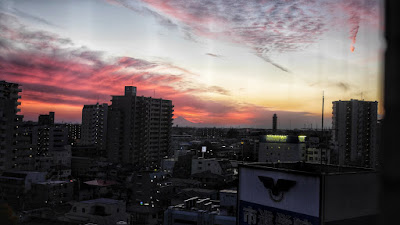What Did Hatsumi Sensei Say Four Times in the First Four Minutes of Training?
From Bujinkan Santa Monica by Michael
 |
| 聖観世音菩薩立像 on top of 万人塚 Banninzuka. photo Michael Glenn |
First, he had Nagase Sensei stab at him and he said,
We’re not studying the form, we’re studying muto dori. ゆっくり。 (Yukkuri)ゆっくり Yukkuri got translated as, “Go slowly or take your time.” But those words in English don’t capture the full idea.
A moment later Soke repeated,
The feeling is very important. ゆっくり。(Yukkuri). You can create this lock here on the elbow. Take the knife. It has to be connected like this. This kind of feeling is important. ゆっくりと。(Yukkuri to)My training partner stabbed at me and I tried to use the feeling that Soke had just shared. But I saw Soke glance at me and he interrupted the entire class again to demonstrate,
This feeling. ゆっくりかな。This was said like a question, "Yukkuri, kana?"
Well, I did wonder. The translation was to go slowly. But in the first four minutes of class Soke had used three or four different ukes and did several henka, all while stressing the importance of yukkuri. Not very slow at all.
Up until that moment, I had a slow day. I visited a memorial for the 明暦の大火 Meireki no taika, also known as the Furisode fire. Which was rumored to start from the burning of a teenager's cursed kimono.
Here I said a prayer at the 万人塚 Banninzuka. This mound of a million souls was set up by the Shogun to bury the many nameless victims of that great fire that killed more than 100,000 people. The gravesite is still a burial place for anyone who has no relatives to look after their funeral.
On the way to the dojo, I bought a coffee at the konbini in the train station. The store clerk was a middle aged man wearing a Santa hat. He asked if I needed a bag. I replied, シールでいいです。 He made a goofy smile as he stuck a piece of tape on the can.
Japanese is full of little phrases that have different meanings in context. Yukkuri is one that you will hear often in Hatsumi Sensei’s class. It can mean to move slowly. But a more subtle meaning is to move at your own pace, in a relaxed way.
You don’t want your opponent to set the tempo of the fight. One time Soke told us,
You don't have to move fast. Slowly, slowly… like a snake that is hunting its prey. You wrap him up with your own body.And another time Tezuka-san stabbed and Soke faded back. He said,
Yukkuri. Keep it connected. With this feeling, you become almost like a (妖怪 youkai) spirit or a monster.When you are able to move at your on pace, in this leisurely way, you draw power from all around. Hatsumi Sensei said that we Daishihan are always taking the Godan test. We must have this connection of the air and of the wind, a connection of the kukan. It is the same idea whether giving or taking the Godan test, where a kind of Divine connection is important.
That is where the power comes from.
Next to the 万人塚 Banninzuka where I said my prayer earlier in the day, there is another mound. It is called 力塚 Chikarazuka, a power mound. It was built as a memorial to past Sumo wrestlers. Now the young ones pray there to draw upon the power of their elders.
I didn’t pray there, because I draw power from Soke and my teachers at the Honbu dojo. We are lucky to have this living art that is not buried in mounds and monuments. I will continue to train Yukkuri, at ease and with my own pace.

